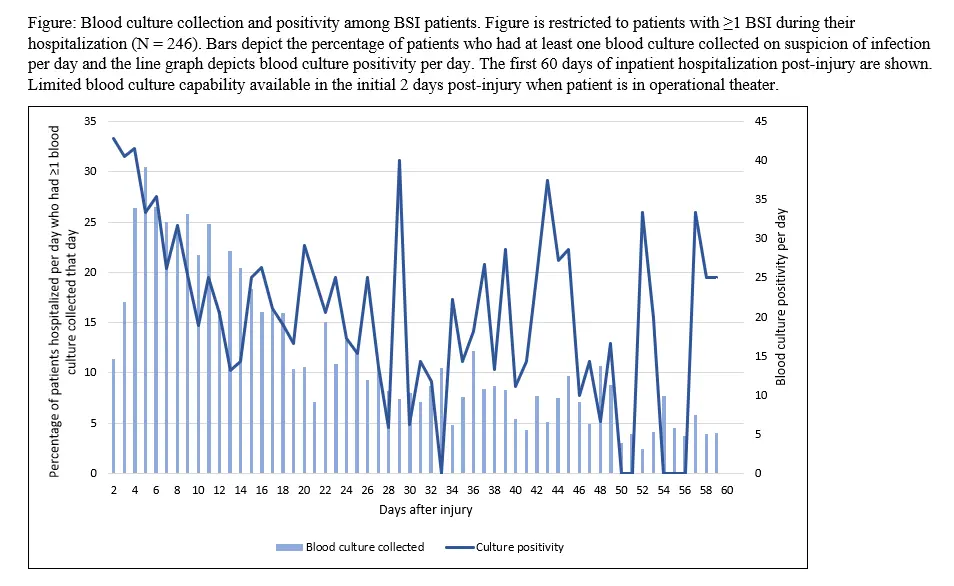Bloodstream Infections Following Battlefield Injury
Author(s):
Sara Robinson; Erica Sercy; Faraz Shaikh; Laveta Stewart; Wesley Campbell; Catherine Decker; Joseph Yabes; Dana Blyth; David Tribble
Background:
Bloodstream infections (BSIs) after civilian trauma are reported to range <1% to 15%.
Hypothesis:
As military trauma is often more severe than civilian trauma, we examined the epidemiology of BSIs following battlefield trauma.
Methods:
Military personnel injured during deployment (2009-2014) who were medevac’d to Landstuhl Regional Medical Center (LRMC, Germany) and transitioned to US military hospitals were examined. CDC National Healthcare Safety Network criteria for BSIs were utilized. Characteristics and incidence density of BSI patients are presented.
Results:
Among 2699 patients, 246 (9.1%) patients were diagnosed with BSI for an incidence density of 3.07 per 1000 inpatient days. Patients were young (median age: 24 years) males (98%) injured via a blast (79%), resulting in critical injury severity (83%). Time to BSI diagnosis at LRMC (N=58) and US military hospitals (N=198) was a median of 3 and 9 days, respectively. BSIs were often polymicrobial (55.2% of cultures), primarily represented by Gram-negative organisms (Acinetobacter baumannii, Pseudomonas aeruginosa, Escherichia coli, Enterobacter spp. and Klebsiella pneumoniae contributing 21%, 19%, 17%, 13% and 11% of polymicrobial infections, respectively). A smaller proportion of polymicrobial cultures included coagulase-negative staphylococci and Enterococcus faecium (17% and 14%, respectively). Multidrug-resistant (MDR) bacteria were isolated from 24% of cultures. The highest proportion of positive blood cultures (Figure), as well as polymicrobial results, occurred 1-7 days and >3 weeks post-injury. Coincident infections were diagnosed for 41% of BSI events with skin and soft-tissue infections (SSTI, 22% of events) and pneumonia (13%) most common. Median length of hospitalization was 53 days and crude mortality was 2%.

Conclusions:
BSIs are a common complication following battlefield injury. Timing of BSIs were most often within the first week or >3 weeks post-injury with rising rates of MDR bacteria in later weeks. Similar to civilian trauma, pneumonia and SSTI remain common infections associated with BSI.
